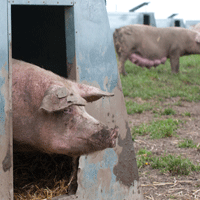Imagine being pregnant and trapped for 24 hours a day, for the duration of your pregnancy, in a tiny crate that prevents you from moving. You can’t turn around, or lie down comfortably or socialize with anyone. Sound like a nightmare? It’s not — it’s the reality for most breeding sows on commercial pig farms in Canada.
“Gestation crates are essentially one of the cruelest forms of confinement used in agriculture today,” explains Sayara Thurston, farm animals’ campaigner for Humane Society International/Canada (HSI/C) in Montreal. “A sow can be in a gestation crate day in and day out for the full four months of her pregnancy. And then she’ll be put in a farrowing crate where she’ll give birth to her piglets, nurse her piglets, and then be re-impregnated and put back into this crate. It adds up to years of her life.”
According to the HSI/C, there are more than 1.4-million breeding sows kept on Canadian farms, and the majority of those are confined in gestation crates. While there are no laws against the use of these crates in Canada, they are being banned in a number of other countries. The UK prohibited them in 1999, and, in 2001, the European Union passed a ban that just came into effect this January. Australia and New Zealand officials plan to phase them out by 2017 and 2015, respectively, and the crates are illegal in nine American States (including Arizona, California and Ohio). Although there are no immediate plans to ban them in Canada, our country’s National Farm Animal Care Council is working on a new Code of Practice for pigs, which would, among other things, set out new industry guidelines on the housing of pregnant sows. The Council hopes to have this Code complete by the end of 2013.
In the meantime, however, in 2012, a number of large North American foodservice companies began publicly declaring their intent to phase gestation crates out of their supply chains. “These are companies like Sysco, Compass Group, Costco, McDonald’s, Burger King, Wendy’s — I could go on and on,” says Thurston, noting there are almost 50 major foodservice companies that have already made this kind of public commitment. “These are not small companies. And, when companies this big are saying: ‘we do not think this practice is humane,’ that’s got to be coming from their consumers.”
McDonald’s was the first to get the ball rolling in February 2012, when the ubiquitous chain announced its commitment to working with its suppliers to end the use of gestation crates. The animal-rights world applauded loudly, and soon Burger King, Wendy’s, Sysco, Tim Hortons, Subway and many others were making similar announcements. In May 2012, McDonald’s followed up its more general February announcement with a specific commitment to phase out the use of gestation crates from its supply chain completely by 2022. (The announcement was made in the U.S., but since McDonald’s Canada sources its pork from American suppliers, it’s a Canadian initiative as well.) “We’ve identified a 10-year phase-in period, because there isn’t enough supply of gestation crate-free pork to supply what McDonald’s in North America needs,” explains Sherry MacLauchlan, director of Government Relations and Sustainability for Toronto-based McDonald’s Canada. “So we need that transition period for suppliers to develop appropriate alternatives.”
But what are those alternatives? Here’s where it gets tricky. The main system producers are being urged to transition to is “group housing” for pregnant sows, where sows are placed into a larger group stall that allows for more freedom of movement. But when you place a number of sows into any confined space together, they can be aggressive. In fact, gestation crates came into being for that very reason: as farming transitioned from the old family farm model to a larger commercial-farming model, more and more pigs were being grouped into pens together, and they got very aggressive. Gestation crates were initially introduced just a few decades ago to protect the pigs from each other — and paradoxically, they were originally seen as being better for the pigs.
“A lot of our producers, especially the older producers, have had experience in group housing, dating back to the ’70s and ’80s, and they weren’t positive experiences,” says Mark Fynn, animal- care specialist at the Manitoba Pork Council. “There were a lot of issues in how the group-housing systems were designed and managed. Sows were getting beat up and not being able to access feed. You’d have scratched up pigs, thin pigs, lots of miscarriages, that sort of thing.”
As a result, it’s an uphill battle to convince many farmers that group housing is best. But, as Fynn explains, there have been huge improvements in group-housing systems since those days of unmanaged aggression. “So, the next thing we need to focus on is getting the information about those [new] systems out to producers. They’re quite different, so the management is going to be different, but also the initial system design on this has to be quite good to manage the aggression that you’re going to see. And, there’s no way around it, you’re going to see aggression between sows, it’s just a natural behaviour, but it’s about finding the systems and management schemes to minimize that aggression,” says Fynn, who notes that, in March 2011, the Manitoba Pork Council released a document encouraging producers to transition to different forms of housing for gestating sows by 2025.
Change, however, is not going to be cheap. “Our estimates are in the range of $600 to $1,000 per sow space,” says Fynn. “So, for a farm that has 200 sows, you’re looking at a $200,000 investment to make that conversion. And, combine that with a lack of confidence in a new system, the effects it could have on cost of production, the loss of productivity and that sort of thing, and it’s very hard for producers to say, ‘Let’s make this investment.’”
Allan Vanden Broek, owner of Broek Pork Acres in Alberta, doesn’t use gestation crates, because his farm isn’t big — they have approximately 60 sows — and they specialize in natural, free-range pork. But, he does sympathize with larger farmers who are under constant financial pressures to farm more pigs. “So, the farmer may make choices that maybe he doesn’t want, but financially he has to,” says Vanden Broek. “I always feel bad for the big farmers.” In this already difficult market for pork farming, he wonders how many won’t be able to endure the costs of transitioning to a new housing system. “It’s hard — a lot of farmers may just leave the industry.”
It may be especially difficult for some farmers to invest in a new system, because although group-housing systems are much better than before, it’s generally accepted throughout the industry that there’s still more work to be done in designing the best system. The foodservice industry is well aware of this challenge. “There’s some conflict about what is the right solution,” says MacLauchlan, who concedes that, while McDonald’s is strongly committed to phasing out the use of gestation crates, they aren’t specialists in raising pigs. “The perfect alternative to gestation crates hasn’t really been defined yet. Certainly, at McDonald’s, we’re not the authority or experts. We’re a stakeholder. We rely on the guidance of animal-health experts and scientists and academics and even government representatives.”
Domino’s Pizza in the U.S., claims to rely on those same experts but found itself the subject of many headline-grabbing news stories and blogs in May 2012 after the chain seemingly refused to commit to phasing out suppliers who use gestation crates. When contacted by F&H, Tim McIntyre, VP of Communications for Domino’s Pizza, explained via email that Domino’s had been misunderstood: “Because we’re not experts (nor do we own, raise, transport or process the animals used in our products), we rely on recognized, established experts, such as farmers, veterinarians and agricultural university researchers, to determine what is best. We will continue to rely on those experts,” he wrote.“What occurred in 2012 was that our shareholders voted down a resolution submitted by HSUS [Humane Society of the United States] calling on us to conduct a study on the topic [of ending the use of gestation crates]. Our position was that there are a significant number of studies out there, and many more that are ongoing, and that our funding yet another one would not be beneficial. Instead, we suggested that we continue to work with our supplier and monitor the scientific evidence before we make a decision of any kind.… For some reason, some media chose to interpret this as us saying something other than what we actually said.”
Meanwhile, the Manitoba Pork Council’s Fynn believes that while some foodservice companies speaking out against gestation crates are genuinely committed to animal welfare and helping their suppliers make a smooth transition to another system — he cites Tim Hortons as having done “a better job of consulting with their suppliers than some of the others,” for instance — he worries too much of what we’re seeing is just about companies jumping to protect their image. “To me, there seems to be a lot of brand protection here, responding to a vocal minority. And, if I thought it was coming more from the general public, that would be good, but the truth of the matter is, it’s coming from [animal-rights] groups that are threatening [chains] with sullying their brand,” says Fynn.
MacLauchlan says that while she can’t speak for anyone else in foodservice, pressure from animal-rights groups wasn’t a major factor in the 2012 McDonald’s announcements. “McDonald’s Canada and globally has a long-standing commitment and record of achievement with regard to animal health and welfare. Beginning in the early 1990s, we established a global advisory council of health and animal-welfare experts to advise us, including Temple Grandin, who is a well-regarded animal-health-and-welfare expert.”
Subway professes a similar long-standing commitment: “The Subway brand, in general, is strongly committed to ethical sourcing and supports the highest standards of animal welfare practices available as well as the advancements that come from continued scientific research. We have strong working relationships with the chicken, pork and beef councils and have our suppliers follow their recommendations in their animal-welfare practices,” explains Elizabeth Stewart, the sandwich chain’s U.S.-based marketing director, via email.
So, as Canada devises its new Code of Practice for pigs, Fynn hopes everyone’s needs will be considered. “We’re relying on this diverse group of stakeholders coming to the table to establish a Code that’s both good for producers and good for the animals and also that meets public expectations,” he says, noting that there’s no quick fix. “We want a balanced approach.”
image courtesy of HSI




















